



Next: Results
Up: Experiments with Image Data
Previous: Experiments with Image Data
Learning Procedure
The phases of the learning procedure are explained in
Chapter ![[*]](cross_ref_motif.gif) . The initialisation of
. The initialisation of
 was
done with FastICA algorithm [28]. The
initialisation procedure is quite similar to the one with VQ. The
results with ICA are presented here, since they were somewhat better
than the ones using VQ. Future work should include a more careful
comparison of different initialisation methods. As ICA is symmetric
with respect to positive and negative values, the mixing matrix was
doubled to include the negative version as can be seen in
Figure
was
done with FastICA algorithm [28]. The
initialisation procedure is quite similar to the one with VQ. The
results with ICA are presented here, since they were somewhat better
than the ones using VQ. Future work should include a more careful
comparison of different initialisation methods. As ICA is symmetric
with respect to positive and negative values, the mixing matrix was
doubled to include the negative version as can be seen in
Figure ![[*]](cross_ref_motif.gif) . The sources were updated for 100 sweeps. Then
the reconstruction error was fed to ICA again, now including also the
variance sources as described in Subsection
. The sources were updated for 100 sweeps. Then
the reconstruction error was fed to ICA again, now including also the
variance sources as described in Subsection ![[*]](cross_ref_motif.gif) . It
results in some more neurons on the second layer which can be seen in
Figure
. It
results in some more neurons on the second layer which can be seen in
Figure ![[*]](cross_ref_motif.gif) .
.
Figure:
70 independent components and the same as negative
versions are used as the initialisation of
 .
.
 is initialised to
zero.
is initialised to
zero.
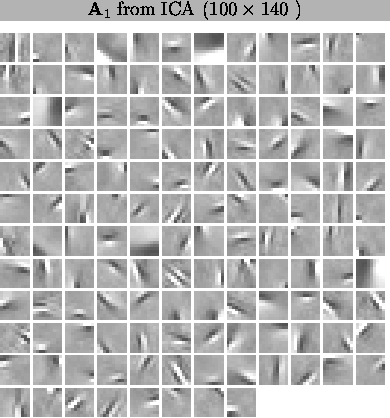 |
Figure:
The vector quantisation (VQ) initialisation with
200 model vectors is shown for comparison. There are more
vectors that use the whole area since VQ yields a maximally
sparse representation. VQ does not have the symmetry between
light and dark and light features are clearly dominating.
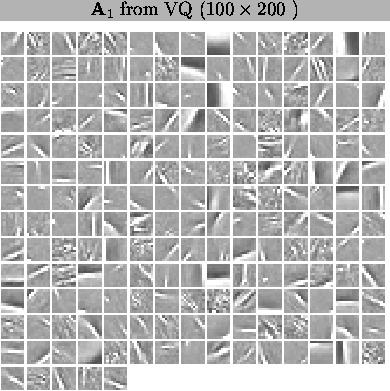 |
Figure:
After 100 sweeps through the data. The reconstruction error of
s1 and
u1 are used as data for another run
on ICA to get more basis vectors. Now the matrix
 has nonzero entries, too.
has nonzero entries, too.
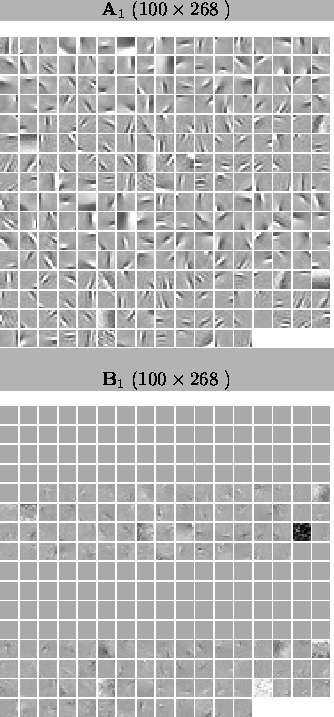 |
The sources were updated for one hundred sweeps and the least useful
ones were removed. Now the second layer had 210 neurons. The sources
were updated until sweep 500 when the sources
s2 and
variance sources
u2 of the second layer were fed to ICA once
again to get initial values for
A2 and
B2 in
Figure ![[*]](cross_ref_motif.gif) . The new sources on the third layer were
updated for 200 sweeps and during that the second layer sources were
updated every fifth sweep.
. The new sources on the third layer were
updated for 200 sweeps and during that the second layer sources were
updated every fifth sweep.
The sources on the second layer are ordered for visualisation purposes
based on the connections from the third layer. Each dimension of the
means of the weights
A2 and
B2 are scaled to
zero mean and unit variance and fed to the self-organising map (SOM)
[39]. The patches are then organised close to their
best matching unit in the SOM.
Figure:
After 500 sweeps through the data. The least useful sources have
been pruned away. The sources of the second layer
s2 and
u2 are fed to ICA to get initial values for
A2 and
B2. The sources have been
ordered based on
A2 and
B2.
The ten patches in
A2 and
B2 correspond to the ten sources on the third
layer. The pixels of
A2 and
B2 correspond to
the 210 sources on the second layer and thus to the patches of
A1 and
B1.
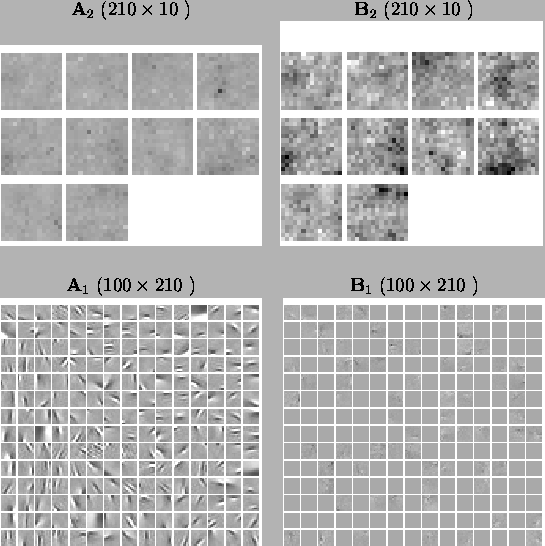 |
Next, also the weights were released to be updated. The second layer
was ``kept alive'' for 1500 sweeps. Figure ![[*]](cross_ref_motif.gif) shows the situation at sweep 1000. The algorithm has simplified the
model by killing neurons. The ``dead'' neurons are removed and everything
is updated without using the special states until finally at sweep
6000 the final results are shown in Figure
shows the situation at sweep 1000. The algorithm has simplified the
model by killing neurons. The ``dead'' neurons are removed and everything
is updated without using the special states until finally at sweep
6000 the final results are shown in Figure ![[*]](cross_ref_motif.gif) .
.
Figure:
At sweep 1000. After releasing the weights the algorithm has
started to simplify the model. Dead neurons can be seen in the
lower left corner of
A1. The patches in
B1 are either clearly close to zero or clearly differ
from zero. The emphasis on the second layer has moved from
B2 to
A2.
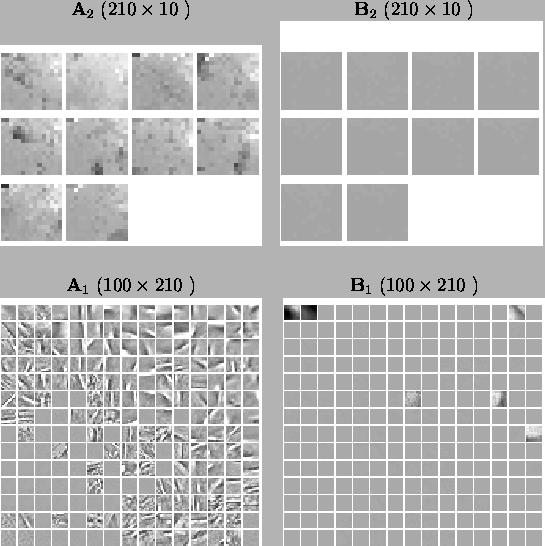 |
Figure:
Results at sweep 6000. ``Dead'' neurons have been removed.
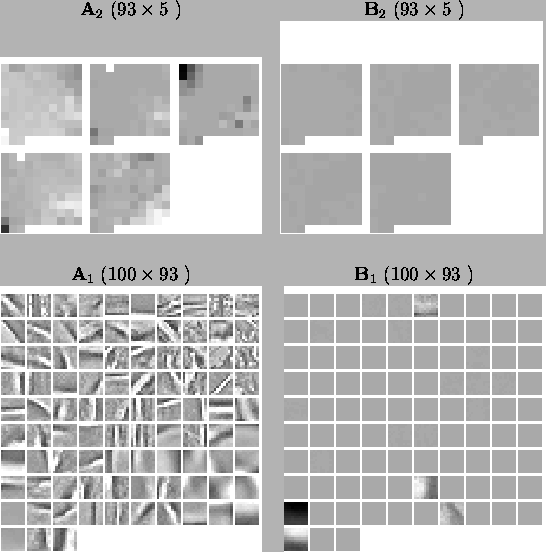 |




Next: Results
Up: Experiments with Image Data
Previous: Experiments with Image Data
Tapani Raiko
2001-12-10
![[*]](cross_ref_motif.gif) . The initialisation of
. The initialisation of
![[*]](cross_ref_motif.gif) . The sources were updated for 100 sweeps. Then
the reconstruction error was fed to ICA again, now including also the
variance sources as described in Subsection
. The sources were updated for 100 sweeps. Then
the reconstruction error was fed to ICA again, now including also the
variance sources as described in Subsection ![[*]](cross_ref_motif.gif) . It
results in some more neurons on the second layer which can be seen in
Figure
. It
results in some more neurons on the second layer which can be seen in
Figure ![[*]](cross_ref_motif.gif) .
.





